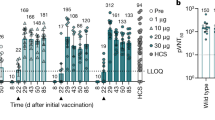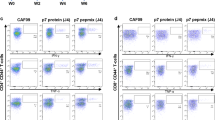Abstract
The hepatitis C virus (HCV) protease and helicase encompasses the nonstructural (NS) 3 protein and the cofactor NS4A, which targets the NS3/4A-complex to intracellular membranes. We here evaluate the importance of NS4A in NS3-based genetic immunogens. A full-length genotype 1 NS3/4A gene was cloned into a eucaryotic expression vector in the form of NS3/4A and NS3 alone. Transient transfections revealed that the inclusion of NS4A increased the expression levels of NS3. Subsequently, immunization with the NS3/4A gene primed 10- to 100-fold higher levels of NS3-specific antibodies as compared to immunization with the NS3 gene. Humoral responses primed by the NS3/4A gene had a higher IgG2a/IgG1 ratio (>20) as compared to the NS3 gene (3.0), suggesting a T helper 1-skewed response. Low dose i.m. (10 μg) immunization with the NS3/4A gene inhibited the growth of NS3/4A-expressing tumor cells in vivo, whereas the NS3 gene alone or NS3 protein did not. We then evaluated the efficiency of the NS3/4A gene administered by the gene gun, at the same doses used for humans, in priming cytotoxic T lymphocyte (CTL) responses. Three to four 4 μg doses of the NS3/4A gene primed CTL at a precursor frequency of 2–4%, which inhibited the growth of NS3/4A-expressing tumor cells in vivo. Thus, NS4A enhances the expression levels and immunogenicity of NS3, and an NS3/4A gene delivered transdermally could be a therapeutic vaccine candidate.
This is a preview of subscription content, access via your institution
Access options
Subscribe to this journal
Receive 12 print issues and online access
$259.00 per year
only $21.58 per issue
Buy this article
- Purchase on Springer Link
- Instant access to full article PDF
Prices may be subject to local taxes which are calculated during checkout










Similar content being viewed by others
References
Weiner AJ et al. Evidence for immune selection of hepatitis-C virus (HCV) putative envelope glycoprotein variants – potential role in chronic HCV infections. Proc Natl Acad Sci USA 1992; 89: 3468–3472.
Ramratnam B et al. Rapid production and clearance of HIV-1 and hepatitis C virus assessed by large volume plasma apheresis. Lancet 1999; 354: 1782–1785.
Ogata N, Alter HJ, Miller RH, Purcell RH . Nucleotide sequence and mutation rate of the H strain of hepatitis C virus. Proc Natl Acad Sci USA 1991; 88: 3392–3396.
Lu L et al. Evaluation of accumulation of hepatitis C virus mutations in a chronically infected chimpanzee: comparison of the core, E1, HVR1, and NS5b regions. J Virol 2001; 75: 3004–3009.
Diepolder HM et al. Immunodominant CD4+ T-cell epitope within nonstructural protein 3 in acute hepatitis C virus infection. J Virol 1997; 71: 6011–6019.
Diepolder HM et al. Possible mechanism involving T-lymphocyte response to non-structural protein 3 in viral clearance in acute hepatitis C virus infection. Lancet 1995; 346: 1006–1007.
Missale G et al. Different clinical behaviors of acute hepatitis C virus infection are associated with different vigor of the anti-viral cell-mediated immune response. J Clin Invest 1996; 98: 706–714.
Bocher WO et al. Induction of strong hepatitis B virus (HBV) specific T helper cell and cytotoxic T lymphocyte responses by therapeutic vaccination in the trimera mouse model of chronic HBV infection. Eur J Immunol 2001; 31: 2071–2079.
Brinster C et al. Different hepatitis C virus nonstructural protein 3 (Ns3)-DNA- expressing vaccines induce in HLA-A2.1 transgenic mice stable cytotoxic T lymphocytes that target one major epitope. Hepatology 2001; 34: 1206–1217.
Encke J, Zu Putlitz J, Geissler M, Wands JR . Genetic immunization generates cellular and humoral immune responses against the nonstructural proteins of the hepatitis C virus in a murine model. J Immunol 1998; 161: 4917–4923.
Forns X et al. DNA immunization of mice and macaques with plasmids encoding hepatitis C virus envelope E2 protein expressed intracellularly and on the cell surface. Vaccine 1999; 17: 1992–2002.
Geissler M et al. Differential cellular and humoral immune responses to HCV core and HBV envelope proteins after genetic immunizations using chimeric constructs. Vaccine 1998; 16: 857–867.
Gordon EJ et al. Immune responses to hepatitis C virus structural and nonstructural proteins induced by plasmid DNA immunizations. J Infect Dis 2000; 181: 42–50.
Inchauspe G et al. Plasmid DNA expressing a secreted or a nonsecreted form of hepatitis C virus nucleocapsid: comparative studies of antibody and T-helper responses following genetic immunization. DNA Cell Biol 1997; 16: 185–195.
Lazdina U et al. Humoral and CD4(+) T helper (Th) cell responses to the hepatitis C virus non-structural 3 (NS3) protein: NS3 primes Th1-like responses more effectively as a DNA-based immunogen than as a recombinant protein. J Gen Virol 2001; 82: 1299–1308.
Major ME et al. DNA-based immunization with chimeric vectors for the induction of immune responses against the hepatitis C virus nucleocapsid. J Virol 1995; 69: 5798–5805.
Satoi J et al. Genetic immunization of wild-type and hepatitis C virus transgenic mice reveals a hierarchy of cellular immune response and tolerance induction against hepatitis C virus structural proteins. J Virol 2001; 75: 12121–12127.
Tokushige K et al. Expression and immune response to hepatitis C virus core DNA-based vaccine constructs. Hepatology 1996; 24: 14–20.
Wolk B et al. Subcellular localization, stability, and trans-cleavage competence of the hepatitis C virus NS3-NS4A complex expressed in tetracycline- regulated cell lines [In Process Citation]. J Virol 2000; 74: 2293–2304.
Tanji Y et al. Hepatitis C virus-encoded nonstructural protein NS4A has versatile functions in viral protein processing. J Virol 1995; 69: 1575–1581.
Bartenschlager R, Ahlborn-Laake L, Mous J, Jacobsen H . Nonstructural protein 3 of the hepatitis C virus encodes a serine-type proteinase required for cleavage at the NS3/4 and NS4/5 junctions. J Virol 1993; 67: 3835–3844.
Bartenschlager R, Lohmann V, Wilkinson T, Koch JO . Complex formation between the NS3 serine-type proteinase of the hepatitis C virus and NS4A and its importance for polyprotein maturation. J Virol 1995; 69: 7519–7528.
Failla C, Tomei L, De Francesco R . Both NS3 and NS4A are required for proteolytic processing of hepatitis C virus nonstructural proteins. J Virol 1994; 68: 3753–3760.
Pang PS, Jankowsky E, Planet PJ, Pyle AM . The hepatitis C viral NS3 protein is a processive DNA helicase with cofactor enhanced RNA unwinding. EMBO J 2002; 21: 1168–1176.
Zhang ZX et al. Characterization of a monoclonal antibody and its single-chain antibody fragment recognizing the nucleoside triphosphatase/helicase domain of the hepatitis C virus nonstructural 3 protein. Clin Diagn Lab Immunol 2000; 7: 58–63.
Ingallinella P et al. Potent peptide inhibitors of human hepatitis C virus NS3 protease are obtained by optimizing the cleavage products. Biochemistry 1998; 37: 8906–8914.
Steinkuhler C et al. Activity of purified hepatitis C virus protease NS3 on peptide substrates. J Virol 1996; 70: 6694–6700.
Sallberg M et al. Immunogenicity and antigenicity of the ATPase/helicase domain of the hepatitis C virus non-structural 3 protein. J Gen Virol 1996; 77: 2721–2728.
Zhang ZX et al. Immune responses to the hepatitis C virus NS4A protein are profoundly influenced by the combination of the viral genotype and the host major histocompatibility complex. J Gen Virol 1997; 78: 2735–2746.
Schirmbeck R, Reimann J . Modulation of gene-gun-mediated Th2 immunity to hepatitis B surface antigen by bacterial CpG motifs or IL-12. Intervirology 2001; 44: 115–123.
Iroegbu J et al. Variability and immunogenicity of human immunodeficiency virus type 1 p24 gene quasispecies. Clin Diagn Lab Immunol 2000; 7: 377–383.
Dal Porto J et al. A soluble divalent class I major histocompatibility complex molecule inhibits alloreactive T cells at nanomolar concentrations. Proc Natl Acad Sci USA 1993; 90: 6671–6675.
Ljunggren HG et al. Empty MHC class I molecules come out in the cold. Nature 1990; 346: 476–480.
Stuber G et al. Assessment of major histocompatibility complex class I interaction with Epstein–Barr virus and human immunodeficiency virus peptides by elevation of membrane H-2 and HLA in peptide loading-deficient cells. Eur J Immunol 1992; 22: 2697–2703.
Roy MJ et al. Induction of antigen-specific CD8+ T cells, T helper cells, and protective levels of antibody in humans by particle-mediated administration of a hepatitis B virus DNA vaccine. Vaccine 2000; 19: 764–778.
Bartenschlager R et al. Substrate determinants for cleavage in cis and in trans by the hepatitis C virus NS3 proteinase. J Virol 1995; 69: 198–205.
Kim JL et al. Crystal structure of the hepatitis C virus NS3 protease domain complexed with a synthetic NS4A cofactor peptide. Cell 1996; 87: 343–355.
Hartmann G et al. Delineation of a CpG phosphorothioate oligodeoxynucleotide for activating primate immune responses in vitro and in vivo. J Immunol 2000; 164: 1617–1624.
Pertmer TM, Roberts TR, Haynes JR . Influenza virus nucleoprotein-specific immunoglobulin G subclass and cytokine responses elicited by DNA vaccination are dependent on the route of vector DNA delivery. J Virol 1996; 70: 6119–6125.
Tuting T et al. Co-delivery of T helper 1-biasing cytokine genes enhances the efficacy of gene gun immunization of mice: studies with the model tumor antigen beta-galactosidase and the BALB/c Meth A p53 tumor-specific antigen. Gene Ther 1999; 6: 629–636.
Garcia-Navarro R et al. Protection against woodchuck hepatitis virus (WHV) infection by gene gun coimmunization with WHV core and interleukin-12. J Virol 2001; 75: 9068–9076.
Rollier C et al. Protective and therapeutic effect of DNA-based immunization against hepadnavirus large envelope protein. Gastroenterology 1999; 116: 658–665.
Sallberg M et al. Genetic immunization of chimpanzees chronically infected with the hepatitis B virus, using a recombinant retroviral vector encoding the hepatitis B virus core antigen. Hum Gene Ther 1998; 9: 1719–1729.
Mehta SH et al. Protection against persistence of hepatitis C. Lancet 2002; 359: 1478–1483.
Leroux-Roels G et al. Lymphoproliferative responses to hepatitis C virus core, E1, E2, and NS3 in patients with chronic hepatitis C infection treated with interferon alfa. Hepatology 1996; 23: 8–16.
Cramp ME et al. Hepatitis C virus-specific T-cell reactivity during interferon and ribavirin treatment in chronic hepatitis C. Gastroenterology 2000; 118: 346–355.
Zhang ZX et al. Interferon-alpha treatment induces delayed CD4 proliferative responses to the hepatitis C virus nonstructural protein 3 regardless of the outcome of therapy. J Infect Dis 1997; 175: 1294–1301.
Sallberg M et al. Rapid “tea-bag” peptide synthesis using 9-fluorenylmethoxycarbonyl (Fmoc) protected amino acids applied for antigenic mapping of viral proteins. Immunol Lett 1991; 30: 59–68.
Jin L, Peterson DL . Expression, isolation, and characterization of the hepatitis C virus ATPase/RNA helicase. Arch Biochem Biophys 1995; 323: 47–53.
Smerdou C, Liljestrom P . Non-viral amplification systems for gene transfer: vectors based on alphaviruses. Curr Opin Mol Ther 1999; 1: 244–251.
Smerdou C, Liljestrom P . Two-helper RNA system for production of recombinant Semliki forest virus particles. J Virol 1999; 73: 1092–1098.
Fleeton MN, Liljestrom P, Sheahan BJ, Atkins GJ . Recombinant Semliki Forest virus particles expressing louping ill virus antigens induce a better protective response than plasmid-based DNA vaccines or an inactivated whole particle vaccine. J Gen Virol 2000; 81: 749–758.
Davis HL et al. Plasmid DNA is superior to viral vectors for direct gene transfer into adult mouse skeletal muscle. Human Gene Therapy 1993; 4: 733–740.
Acknowledgements
This study was supported by grant no. K2000-06X-12617-03A and K2002-16X-09494-12B from the Swedish Research Council, and by grant no. QLK2-1999-00588 from the European Community. BR was supported by the Wallenberg Consortia North for Functional Genomics.
Author information
Authors and Affiliations
Rights and permissions
About this article
Cite this article
Frelin, L., Alheim, M., Chen, A. et al. Low dose and gene gun immunization with a hepatitis C virus nonstructural (NS) 3 DNA-based vaccine containing NS4A inhibit NS3/4A-expressing tumors in vivo. Gene Ther 10, 686–699 (2003). https://doi.org/10.1038/sj.gt.3301933
Received:
Accepted:
Published:
Issue Date:
DOI: https://doi.org/10.1038/sj.gt.3301933
Keywords
This article is cited by
-
Hepatitis C virus DNA vaccines: a systematic review
Virology Journal (2021)
-
A targeted controlled force injection of genetic material in vivo
Molecular Therapy - Methods & Clinical Development (2016)
-
Functional differences in hepatitis C virus nonstructural (NS) 3/4A- and 5A-specific T cell responses
Scientific Reports (2016)
-
Short noncoding DNA fragments improve the immune potency of electroporation-mediated HBV DNA vaccination
Gene Therapy (2014)
-
Long-term functional duration of immune responses to HCV NS3/4A induced by DNA vaccination
Gene Therapy (2014)



